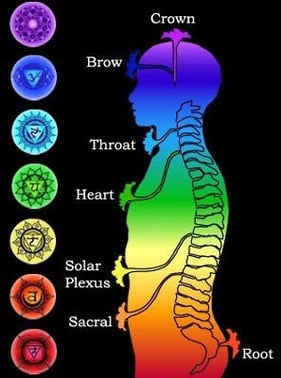Understanding the chakras - Blog - Reeve Foundation
During yoga and meditation, we use the breath to bring awareness and mindfulness to our practice. We also use visualization focusing on a brilliant gold ball of light traveling up and down our spine with the expansion of the breath. Another important component of meditation is the internal awareness of the seven chakras in our spirit body that collaborate with the breath and visualization techniques. Chakra is an Indian Sanskrit word meaning wheel or disk that literally translates to the idea of a spinning energetic wheel in seven distinct areas of our spine where our prana, chi or life force flows up and down.
These seven energetic spiritual wheels begin at the very base of our spine and traverse vertically to the crown of the head – they each have a coordinating color, organ representation and location in the physical body. When performing meditation, it is important to imagine the gold ball of light circling smoothly through each of these colorful wheels, allowing prana to flow. This is hugely important in maintaining balance between our physical and spiritual body. On the contrary, if a chakra is blocked, a backup of energy festers causing a disease situation in the physical bodies hence the importance of performing daily meditation to avoid such blockage.
 The first chakra, or root chakra, is Muladhara in Sanskrit, and called is nestled in the base of the spine. It represents our source of physical stability and basic needs on this earth such as nourishment. Collaborating organs are the spine, skeletal system and immune system. When our root chakra is open, we feel fearless, secure and grounded. Contrarily, a blockage here allows insecurity, depression and or fear to manifest. Its associated color is red.
The first chakra, or root chakra, is Muladhara in Sanskrit, and called is nestled in the base of the spine. It represents our source of physical stability and basic needs on this earth such as nourishment. Collaborating organs are the spine, skeletal system and immune system. When our root chakra is open, we feel fearless, secure and grounded. Contrarily, a blockage here allows insecurity, depression and or fear to manifest. Its associated color is red.
The second chakra, or sacral chakra, is called Svadhisthana in Sanskrit, and is positioned above the pubic bone. It represents our source of creativity and sexuality and the coordinating organs are the reproductive system, kidney and bladder. When the sacral chakra is open, we imbibe in our creative expression and emotionally connect with others. If blocked, the physical body may experience reproductive issues or an inability to receive pleasure. Its associated color is orange.
The third chakra, or solar plexus, is called Manipura, in Sanskrit, and is located between the navel and breastbone. It represents our personal power system and the seat of our ego, strength and anger. Respective organs are the stomach, intestines, gallbladder, liver, pancreas and spleen. When the solar plexus is open, we are confident, in control and feel immense self-esteem. A blockage here can represent digestion or liver/gallbladder issues and spiritually cause an inability to control oneself and or fear of rejection. Its associated color is yellow.
The fourth chakra, or Anahata, is the heart center – it acts as a bridge between the first three physical body related chakras with the upper three more spiritual chakras. This is our center of love and healing. Collaborating organs are the heart, respiratory system, and breasts. When the heart chakra is open, we may love freely, have great compassion and foster healthy emotional relationships with others. Contrarily, a block at this chakra may represent heartache, an inability to love oneself and even a physical manifestation of heart disease. Its associated color is light green.
The fifth chakra, or Vishuddha in Sanskrit, is located in the throat area. An area of verbal expression, this relates to our ability to speak the truth and avoid lying. Collaborating organs include the thyroid, neck vertebrae, esophagus, mouth, teeth and gums. When the throat chakra is open, we are able to communicate and express ourselves truthfully and freely. Its associated color is sky-blue.
The sixth chakra, or Ajna in Sanskrit, is also known as the "third eye" – this is the center of our higher intuition. Located centrally on the forehead, strength in this area helps one disseminate between fantasy and reality and is the seat of one's wisdom. Collaborating organs include the eyes, nose, face and brain. A strong third eye helps one to learn from experience and tap into one's higher self. Its associated color is indigo.
The seventh and final chakra, or Sahaswara, is represented by a 1000 petal lotus and is located at the highest point – the crown of the head. This is the center of spiritual enlightenment and when fully open helps us connect with God and or a higher power. Collaborating organs include the nervous system and brain. An area of ultimate understanding and knowledge, it is the chakra that allows for inward flow of wisdom from the divine – an extremely important area for our spiritual connectedness. Its associated color is violet or white.
Only scratching the surface with unveiling the details of the seven chakras, it is most important in our meditation practice to be aware of these centers in the spirit body. Staying connected and balanced between the physical and spirit body provides for a healthy mind, body and spirit. Working through spinal cord injuries is and often times difficult time to maintain such balance, and so therefore during rehabilitation it is important to connect inward so as to heal within. Whether it is one-week, six months or 10 years after injury, this practice is crucial in our overall well-being.
Namaste!
Keep on keeping on,
Elizabeth/EB Forst
Join Our Movement
What started as an idea has become a national movement. With your support, we can influence policy and inspire lasting change.
Become an Advocate